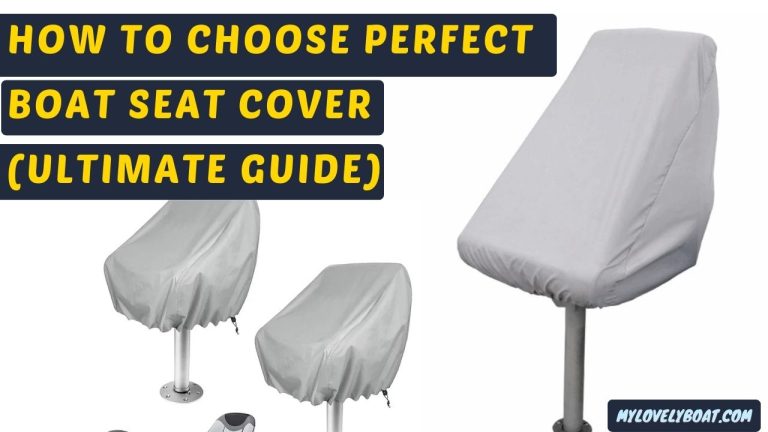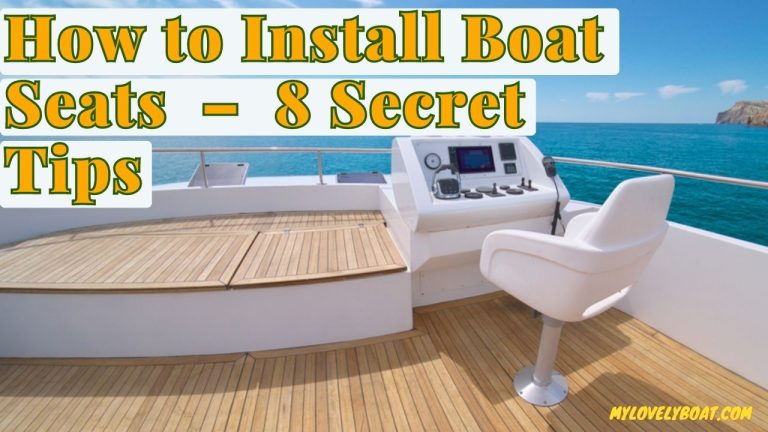
Taking care of your boat seats is crucial for maintaining their appearance and longevity. Boat seats are exposed to various elements like sun, moisture, and dirt, which can lead to wear and tear over time. In this comprehensive guide, we will share nine tricks to help you keep your boat seats looking new. From using seat covers to proper cleaning techniques, we’ve got you covered. Let’s dive in!
What Are the Best Tips for Keeping Boat Seats Looking New?
These are the most important tips and tricks when cleaning and maintaining your boat seats.
Trick 1: Choose the Right Materials
Regarding boat seat maintenance, selecting the appropriate materials is vital in ensuring durability and comfort. There are various materials used in boat seats, each with advantages and disadvantages.
- Vinyl: Boat seats are often made of a cost-effective, water-resistant material that’s easy to clean but can fade and crack without proper care.
- Marine-grade fabric: Marine-grade fabric is pricier but lasts longer than vinyl. It resists UV rays, repels water, and allows for breathability.
- Leather: Leather boat seats require upkeep and can be damaged by water and sun exposure.
- Molded plastic: Plastic seats are durable and low-cost but less comfortable and visually appealing than other materials.
When choosing the best material for your boat seats, consider the following factors:
- Budget: If you’re on a tight budget, vinyl or molded plastic seats are the most cost-effective options.
- Maintenance: For low-maintenance options, opt for marine-grade fabric or moulded plastic.
- Comfort: Leather and marine-grade fabric offer superior comfort, though at a higher price point.
- Aesthetics: Leather and marine-grade fabric provide a more upscale look, while vinyl and moulded plastic have a more utilitarian appearance.
Ultimately, the best material for your boat seats depends on your needs, budget, and preferences.
Trick 2: Keep Your Boat Seats Clean:
Regular cleaning is essential to prevent dirt and debris buildup on your boat seats, which can lead to discolouration and damage over time. Establishing a consistent cleaning routine will help maintain the appearance and longevity of your seats.
Recommended cleaning tools and products include a soft-bristle brush, mild soap, and clean water. You may also use a vinyl seat cleaner specifically designed for marine applications.
Step-by-step cleaning instructions:
- Remove any loose dirt and debris by gently brushing the seat surface.
- Mix a mild soap solution in a bucket of water.
- Dip the soft-bristle brush into the soap solution and gently scrub the boat seat surface, working in small sections.
- Rinse the seat thoroughly with clean water to remove soap residue.
- Pat the seat dry with a clean, soft cloth or towel.
These simple steps will keep your boat seats clean and looking their best.
Trick 3: Use Protective Covers:
Protective covers are crucial in preventing damage to boat seats by shielding them from direct sunlight, rain, and other environmental factors. They also help to keep dirt and debris off the seats, reducing the need for frequent cleaning.
There are several types of covers available in the market:
- Custom-fit covers: This custom boat seat covers provide ideal seat protection and are a valuable long-term investment.
- Universal-fit covers: Custom boat seat covers offer better protection than generic ones that are made to fit different sizes and shapes.
- Seat cushions with integrated covers: Dual-function boat seat cushions: enhance comfort and protection. Detachable for easy cleaning and storage.
Consider your budget, protection needs, and convenience when choosing a boat seat cover. Custom-fit offers optimal protection, while universal-fit or seat cushions are budget-friendly.
Trick 4: Limit Sun Exposure:
Prolonged exposure to sunlight can damage boat seats by causing fading, discolouration, and material degradation. Ultraviolet (UV) rays from the sun can weaken the fibres in the seat material, making it more susceptible to tearing and wear.
To protect your boat seats from sun damage, consider the following recommendations:
- Use shades: By installing a boat shade like a Bimini top, you can protect your boat seats from the sun’s harsh rays and still relax on the water.
- Utilize protective covers: Protect your boat seats from sun damage with UV-resistant covers.
- Park in shaded areas: When docking or storing your boat, choose shady locations to minimize sun exposure.
Implementing these proactive measures is crucial to safeguard your boat seats from sun damage and keep them in top-notch condition for a long time.
Trick 5: Store Your Boat Seats Properly:
Proper storage is crucial to maintain the longevity and quality of your boat seats. Leaving them exposed to harsh elements such as sunlight, moisture, and extreme temperatures can cause damage and ultimately shorten their lifespan.
Here are some tips to help you store your boat seats properly:
- Cover boat seats with a protective cover made of breathable material to keep them clean and free from dust.
- Store your boat seats in a dry, cool place. Avoid areas that are exposed to direct sunlight or extreme temperatures.
- Remove and store the cushions separately if you’re storing your boat seats for an extended period. This will help to prevent mould and mildew growth.
By following these simple steps, you can ensure that your boat seats remain in excellent condition and are ready to use whenever you need them.
Trick 6: Address Damages Immediately:
To ensure the longevity of your boat seats, it’s crucial to address any damages promptly. Neglecting damages can worsen the situation and significantly reduce the lifespan of the seats.
The most common types of damage are tears, stains, and cracks that occur due to exposure to sun, moisture, and wear and tear. To prevent further damage, it’s essential to regularly inspect your seats and take immediate action if you notice any issues.
You can use DIY solutions like cleaning with appropriate products and patching for minor damages like stains and small tears.
However, it’s best to seek professional repair immediately for significant damages that affect the seat’s structural integrity or lead to sagging and cracks.
Trick 7: Use Conditioners
Conditioners play a vital role in maintaining boat seats’ pristine appearance and extending their lifespan. They protect against UV rays, moisture, and dirt, preventing wear and tear. Various conditioners are available in the market, catering to diverse requirements and budgets.
For instance, 303 Aerospace Protectant offers excellent UV protection and repels water, while Star Brite’s Ultimate Vinyl Guard provides long-lasting shine with its PTEF polymers. Leather seats benefit from Leather Honey’s conditioner, which penetrates deep into the material, nourishing and protecting it.
Ultimately, the choice depends on your specific needs and budget, but investing in a quality conditioner is essential for optimal seat maintenance.
Trick 8: Avoid Sharp Objects
Sharp objects and boat seats are not a good combination. Even the most minor cut or puncture can lead to significant damage.
Be mindful of items such as fishing hooks, knives, keys, or any sharp objects that can come into contact with your seats. Establish clear rules for your passengers and crew to prevent accidental damage.
Consider using protective seat covers or designated storage compartments to minimize the risk of sharp objects causing harm to your seats.
Trick 9: Keep Them Dry
Moisture is another factor that can wreak havoc on your boat seats.
Excessive moisture can lead to mold, mildew, and rot, causing irreversible damage. After each boating trip, dry your seats thoroughly to prevent moisture buildup. Wipe them down with a clean, absorbent cloth or towel to remove any moisture.
If your seats get wet from rain or splashing waves, allow them to air dry before covering or storing them. Keeping your boat seats dry is essential for their longevity and for preventing damaging microorganisms’ growth.
Trick 10: Use the Right Products
Using the right cleaning products is crucial for maintaining the integrity of your boat seats.
Avoid harsh chemicals or abrasive cleaners that can cause discolouration or deterioration of the seat material. Instead, opt for mild, boat-specific cleaners designed to effectively remove stains and grime without causing harm.
Always check the product labels and follow the instructions carefully to ensure safe and effective cleaning. Using the right products will help preserve the quality and appearance of your boat seats.
What Are the Best Cleaning Products for Boat Seats?
Many great cleaning products are available to keep your boat seats looking their best. Here are some of the best:
FAQs
Can I use household cleaning products on my boat seats?
Using household cleaning products on boat seats is generally not recommended, as they may contain harsh chemicals that can damage or discolour the seat material. Stick to cleaners designed explicitly for boat upholstery.
How often should I clean my boat seats?
The frequency of cleaning depends on factors such as usage, environmental conditions, and stains or dirt. As a general guideline, aim to clean your boat seats at least once a month and more frequently if needed.
Can I use a tarp to cover my boat seats?
While a tarp may provide some protection from dirt and moisture, it’s not an ideal choice for covering boat seats. Tarp material may not be breathable, leading to moisture accumulation and potential seat damage.
How can I protect my boat seats from sun damage?
To protect your boat seats from sun damage, consider using UV-resistant seat covers, applying specialized UV protectants, or parking your boat in shaded areas. These measures help minimize the impact of UV rays on the seat material.
What should I do if I notice damage to my boat seats?
If you notice damage to your boat seats, such as cuts, tears, or cracks, it’s important to address it promptly. Depending on the severity of the damage, you may need to seek professional repair or consider replacing the affected seats.
Can I leave my boat seats outside during the winter?
Protect your boat seats during winter by storing them indoors or with weather-resistant covers to prevent extreme cold, snow, and ice damage.
Further Reading
- Top 18 Duck Hunting Boat Accessories
- Top 20 Must-Have Dog Boat Accessories
- Top 19 Accessories for Safe and Comfortable Boating with Baby
- The Top 20 Fun Boat Accessories
- Top 8 Cool Boat Accessories for Tech-Savvy Boaters
- Top 12 Must-Have Boat Party Accessories
- 15 Portable Cooking Accessories Perfect for Boating Adventures
- Must-Have Boat Picnic Accessories

I am a freelance writer passionate about watersports and the great outdoors. I have many years of experience in the marine industry, and I enjoy sharing my knowledge and expertise with others so that they can get the most out of their boating experiences. I like fishing, kayaking, and exploring new destinations by boat whenever I have time. Contact Us: Linkedin





